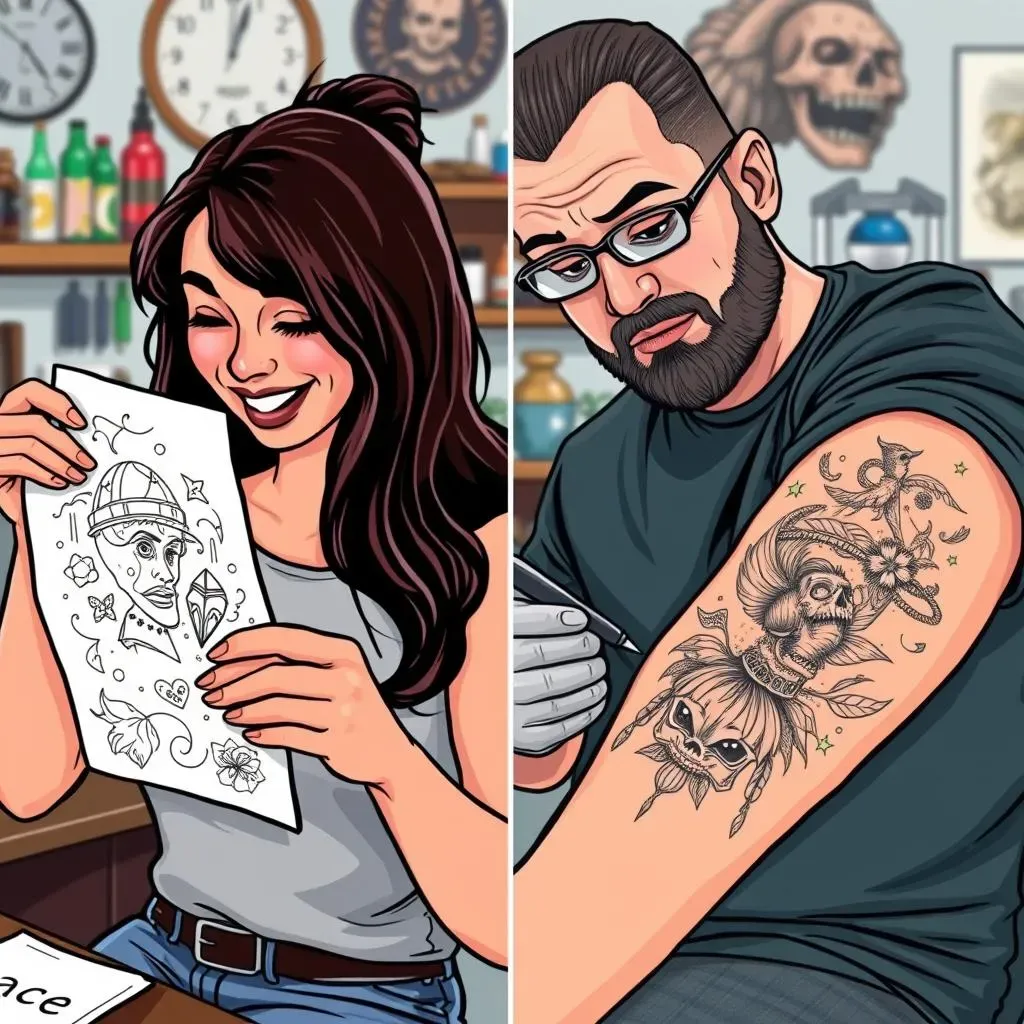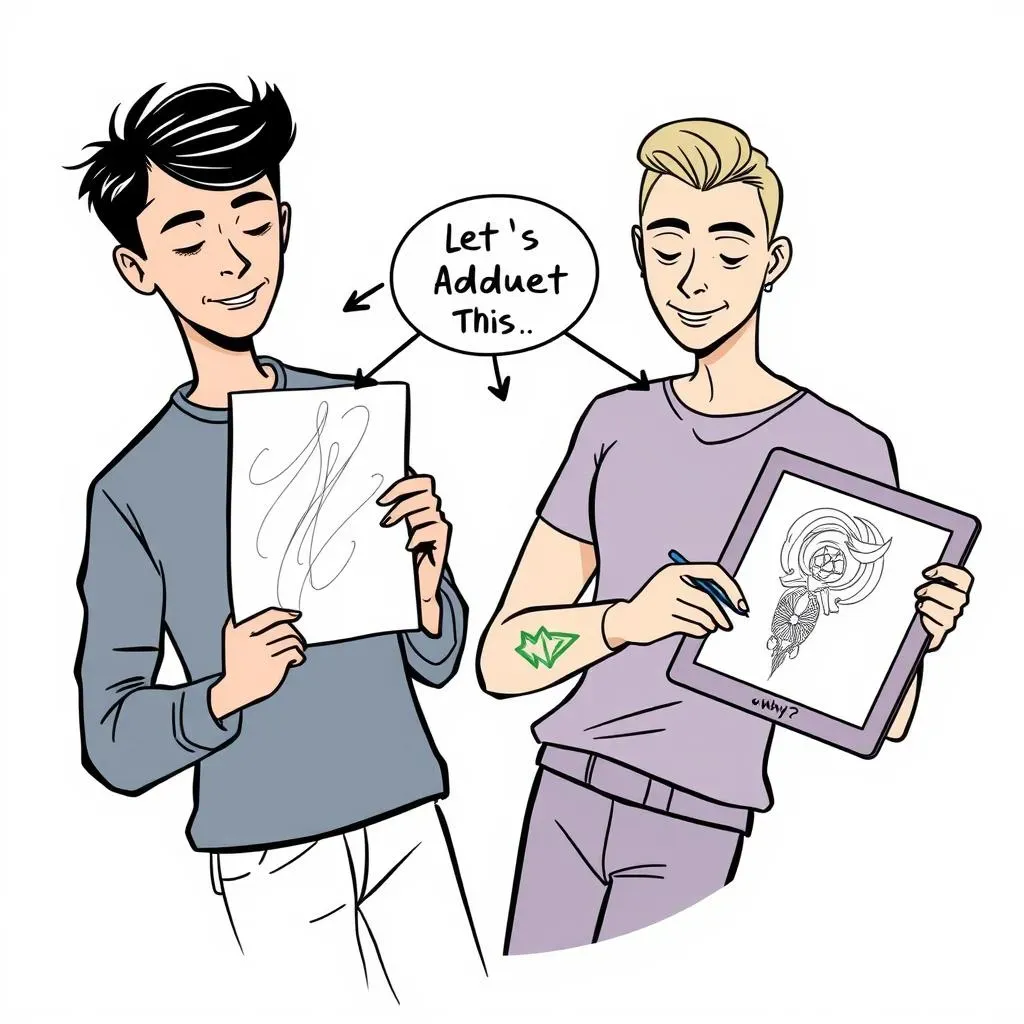Table of Contents
Ever dreamt of getting inked with a design that's uniquely yours? You've probably got a sketch, a doodle, or maybe even a full-blown masterpiece you're itching to get on your skin. But then the big question pops into your head: "Can I bring a design to a tattoo artist?" It's a valid worry, and it's something many first-timers (and even seasoned tattoo enthusiasts) wonder about. This article is your guide to navigating that very question. We'll explore the ins and outs of bringing your own artwork to a tattoo shop. We'll discuss how to approach your artist, what to expect when they review your design, and what to do if they suggest some changes. Think of this as your crash course in custom tattoo etiquette. We are here to help you turn your vision into a stunning piece of body art, so let’s get started.
Bringing Your Own Tattoo Design: Is It Okay?
Bringing Your Own Tattoo Design: Is It Okay?
The Short Answer: Yes, Mostly
So, you've got this awesome design swirling around in your head, or maybe it's already on paper. You're probably wondering if tattoo artists are cool with you bringing your own stuff. Good news, most of the time, they are! Tattoo artists are used to people coming in with their own ideas. It's actually pretty common. They know it’s your body, and you should have a say in what goes on it. Think of it like ordering a burger: you can ask for specific toppings, right? Same deal with tattoos, you can bring your own "toppings" (aka your design).
However, it’s not always a simple yes. Some artists prefer to work from scratch, creating something original for each client. They might see your design as a starting point, not the final product. Some artists specialize in specific styles, and your drawing might not fit their expertise. For example, if you bring a super detailed, realistic portrait to an artist who mainly does bold, traditional tattoos, it might not be the best match. It's all about finding the right artist for your vision.
Artist Preference | Your Design | Outcome |
|---|---|---|
Prefers original work | Brings in a complex design | May ask to redraw or collaborate |
Open to client art | Simple, clean design | Likely to use the design with minor tweaks |
Specializes in a style | Design does not match their style | May recommend another artist or request modifications |
It's a Collaboration, Not a Dictation
Think of bringing your own design as the start of a conversation. It’s not about handing over a drawing and saying, "Make this exactly as it is." It's more like saying, "Hey, I love this idea, can we work together to make it awesome?" Tattoo artists are artists, after all. They have the skills to turn your concept into something that will look amazing and last a long time. They know about things like line weight, color mixing, and how designs age on skin. They might suggest changes to make your tattoo look better, fit better, and heal well. Remember, they want you to be happy with your tattoo, too.
For example, you might have a super intricate design with a lot of tiny details. A good artist might suggest simplifying some of those details. Tiny lines can blur over time, and they want your tattoo to look great for years to come. It's not that they don't like your design, it's that they want to give you the best possible tattoo. They are the experts in this field, and it's wise to listen to their input. This is why communication is key, it's a team effort!
“The best tattoos are a collaboration between the client's vision and the artist's skill.” - A random tattoo artist somewhere.
Working With Your Tattoo Artist on a Custom Design
Working With Your Tattoo Artist on a Custom Design
Finding the Right Artist
so you're stoked about your design, but now what? Finding the right artist is like finding the perfect pair of shoes—it has to be a good fit. Start by checking out artists' portfolios online. Most of them have Instagram pages or websites where they show off their work. Look for someone whose style matches your design. If you're going for a watercolor effect, don't go to the guy who only does black and grey tribal. It's like trying to get a pizza at a sushi restaurant, it just won't work out. Take your time and do your research. You wouldn't let just anyone cut your hair, right? Same goes for tattoos.
Once you have a few artists in mind, reach out to them. Most shops have a process for consultations. Don't be shy, this is your chance to chat about your vision and see if you click with the artist. It's a two-way street, you want to feel comfortable with them, and they should be excited about your project. If you are looking for a very particular style, make sure they are comfortable with it. Some artist are more flexible, some are not, it is ok to find someone who matches your vibe.
- Check portfolios: Look for artists whose style matches your design.
- Read reviews: See what other clients say about their experience.
- Schedule a consultation: Discuss your ideas and get to know the artist.
- Trust your gut: Choose someone you feel comfortable with and who understands your vision.
The Consultation: Bring Your A-Game
The consultation is your time to shine and to show the artist what you're working with. This is not a moment to be shy, bring your design, any reference pictures, and be ready to talk about your ideas. Even if your drawing is just a stick figure, it's the concept that matters. Explain what you like about it, what it means to you, and any specific details you want to include. The more information you give the artist, the better they can understand your vision. Remember, they are not mind readers. This is your chance to ensure they understand what you want.
Be open to the artist's suggestions. They might see ways to improve your design that you hadn't thought of. They know what works well as a tattoo, and they might have some great ideas to make it even better. It's not about them taking over your idea, it's about them helping you create the best possible tattoo. It's about finding that sweet spot where your vision meets their expertise. Think of it like a recipe, you've got the ingredients, and they're the chef who knows how to put it all together.
“Communication is key, so don't be afraid to ask questions and share your thoughts.”
What Happens if Your Design Needs Adjustments?
What Happens if Your Design Needs Adjustments?
The Artist's Perspective
So, you've poured your heart into this design, but your artist suggests changes. Don't freak out! It's not that they hate your art. It's more like they see a way to make it even better, like a director tweaking a movie script. Tattooing is different from drawing on paper. Skin moves, it heals, and it changes over time. An artist might suggest adjustments to ensure your tattoo looks great for years to come. For instance, those super thin lines you love might blur together over time, turning into a blob. Or a design that looks great on a flat surface might not flow well on the curve of your arm. These are things the artist is trained to see and fix.
They might propose a few tweaks, like making lines bolder, adjusting the spacing, or simplifying some details. These aren't personal attacks on your artistic talent; they're practical decisions to ensure your tattoo is amazing. Think of it like a tailor adjusting a suit – they're making sure it fits you perfectly. Good tattoo artists have a keen eye for what works and what doesn’t. They will explain their reasoning, and it's your job to listen and understand their perspective. This is not about compromising your vision, it is about making it the best it can be.
Adjustment | Reason | Benefit |
|---|---|---|
Making lines bolder | Thin lines may blur over time | Ensures the tattoo remains clear and defined |
Adjusting spacing | Too much or too little spacing can affect readability | Improves the overall look and flow of the tattoo |
Simplifying details | Complex details may not translate well on skin | Makes the tattoo more durable and less likely to fade |
Navigating Changes: Be Flexible
The key here is flexibility. It's okay to have a strong vision, but try to be open to suggestions. If your artist proposes changes, ask why. Understand their reasoning. If they are suggesting something you don't like, voice your concerns. This is a conversation, not a dictatorship. You can work together to find a solution that you both are happy with. Maybe you can find a middle ground, a slight adjustment that keeps the essence of your design while making it tattoo-ready. Remember, a good artist wants you to love your tattoo as much as you do. It is a collaborative process, and both of your opinions matter.
If you are absolutely against any changes, it's okay to say so. Maybe that artist isn’t the right fit, and you might need to find someone who can execute your design exactly as you want it. It’s your body and your tattoo, and you should be happy with the final result. However, before you walk away, try to understand the artist's perspective. They have years of experience, and their advice is usually worth considering. It's like getting a second opinion from a doctor - it's always good to have all the information before making a decision. It's about finding a balance between your vision and their expertise.
“Be open to suggestions, but don't be afraid to stand your ground if you're not comfortable with a proposed change.”
Wrapping Up: Your Design, Your Ink
So, can you bring your own design to a tattoo artist? Absolutely! But remember, it's a collaborative process. Your artist isn't just a human printer; they’re a skilled professional who wants the best outcome for your tattoo. Be open to their feedback, understand that some adjustments might be necessary, and trust their expertise. By communicating clearly and working together, you can transform your personal vision into a piece of art that you’ll be proud to wear for a lifetime. Now go forth, get designing, and get inked!